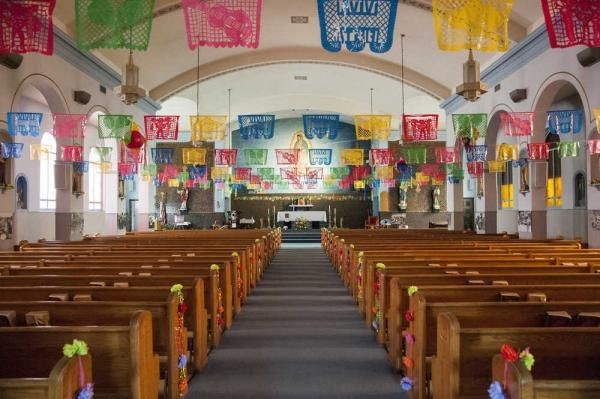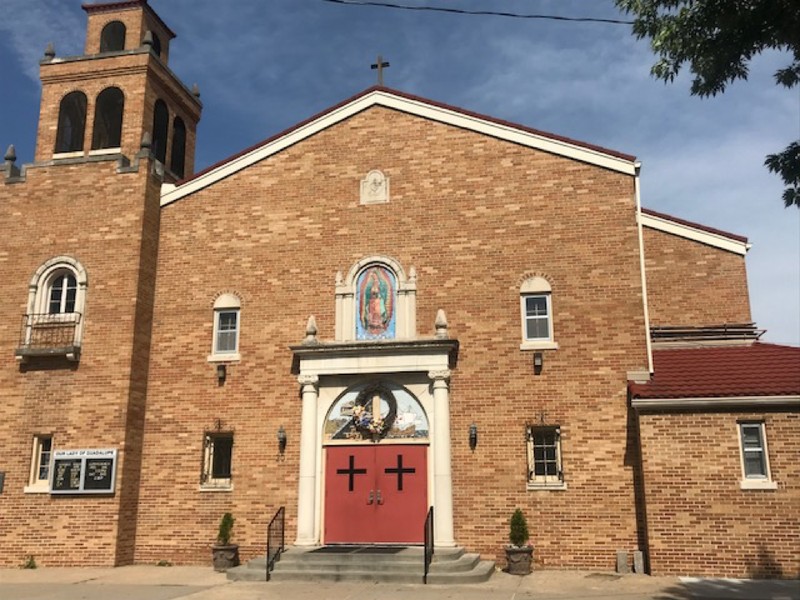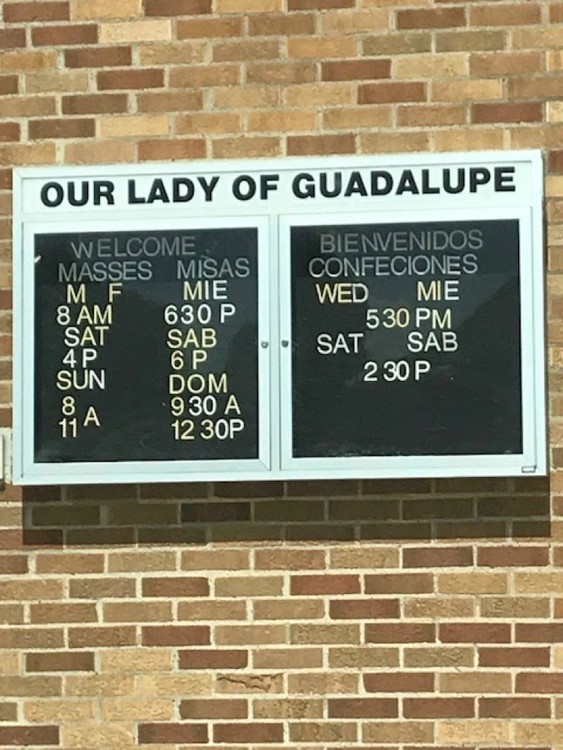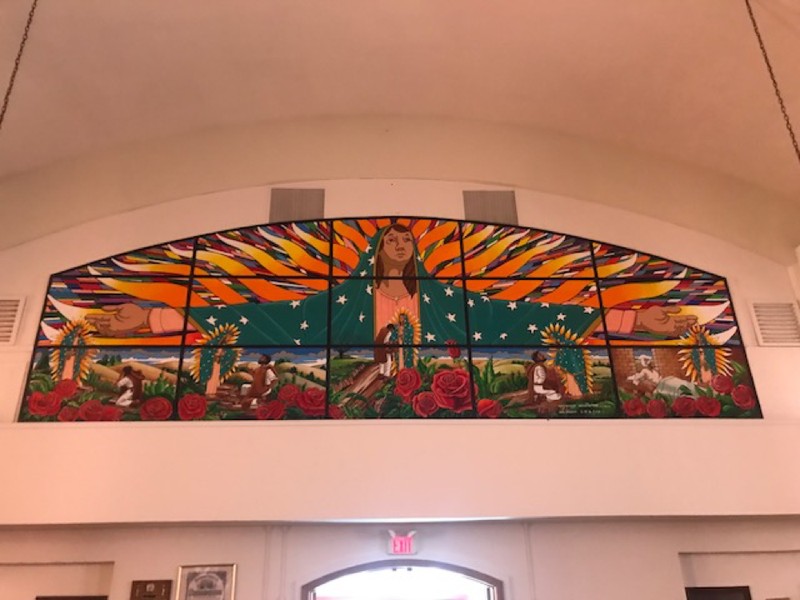Our Lady of Guadalupe Church
Introduction
Text-to-speech Audio
Founded in 1914, Our Lady of Guadalupe Parish was started and organized because of the enthusiastic interest of twenty families who migrated from Mexico to escape poverty or the Revolution of 1910. The movement was influenced by the growth of railroads and the need for labor during and after World War I. Throughout the history of the parish, no matter the challenges that were faced, the parishioners maintained their faith and strengthened their efforts to keep the parish open. The parishioners have contributed generously to its growth and progress.
Images
The Stations from Our Lady of Guadalupe

Our Lady of Guadalupe was established in 1914 and this church was completed in 1921.

Time schedule for Our Lady of Guadalupe Church

Our Lady of Guadalupe (Inside)

Backstory and Context
Text-to-speech Audio
On a hot July day in 1914, Pedro Lopez was at the railroad station to send off a package. While there he recognized a Mexican priest named Father Epifanio Ocampo. They began to talk and in the course of the conversation, Pedro Lopez expressed his and the Mexican community’s desire for their own Catholic parish. Father Ocampo agreed to help Mr. Lopez and then the pair began to talk to other priests in Topeka in an effort to gain support in the forming of a parish.
Father Ocampo and Mr. Lopez were successful in their efforts, and Our Lady of Guadalupe Church was established on November 4, 1914. The first church, a small rented store on the corner of Crane and Branner, was blessed by Rev. John Ward, Bishop of the Catholic diocese of Leavenworth at 2 p.m. The first services were attended by 350 Mexican-American Catholics. The people attended mass weekly in this church until 1921 when a second church was built on Branner Street. The second church was truly a church of the people as parishioners donated their time, money, skills toward the eventual completion of their church.
Jorge Iber underscores the importance of Our Lady of Guadalupe Church,
"From this humble chapel emanated some of the earliest attempts to introduce the rich Mexican culture to the broader community. Among the undertakings used to share ethnic traditions with fellow Topekans were the Fiesta Mexicana, started in 1932, and the Christmas tradition of Las Posadas, first held in 1936. The Fiesta became not only a mechanism for displaying cultural pride, but also a substantial money maker. By the 1940s this enterprise was the principal fundraiser for the parish and helped pay for the construction of a new building, completed in 1948" (Iber, 2016)
Our Lady of Guadalupe Church has been and continues to be a center, a home, a haven, a refuge in time of trouble to thousands of immigrants and Mexican Americans in the community. Our Lady of Guadalupe Church is the only parish in the Topeka community which offers masses in Spanish. The parishioners continue to share their faith and rich cultural heritage with Topeka and its surrounding communities through their actions and celebration of the Annual Fiesta Mexicana. The royalty food sales in Our Lady of Guadalupe Church sustain the neighborhood’s vitality and economic independence. Some traditional Mexican American food sold at the royalty food sales include: beef tacos, beef enchiladas, burritos and tostadas, tamales, rice and beans.
Spanish Translation/Traducción en Español
El 28 de agosto del 1963 fue una fecha importante para Virginia Gomez y John Mendoza. Ese día estos dos enamorados se vistieron en sus mejores vestidos matrimoniales y decidieron casarse en una de las iglesias mas importantes y llevada en los corazones de los residentes del vecindario de Oakland. Virginia y John se casaron en la parroquia de Nuestra Señora de Guadalupe en Topeka, Kansas.
Fundada en 1914, la Parroquia de Nuestra Señora de Guadalupe fue organizada debido al entusiasmo e interés de veinte familias quienes emigraron de México para escapar la pobreza y La Revolución del 1910. El movimiento de estas familias fue influenciado debido al crecimiento de vías de tren y la necesidad de trabajar durante y después de la primera guerra mundial. A través de la historia de la parroquia, sin importar los desafíos, los feligreses han mantenido su fe y fortalecieron sus esfuerzos para mantener la parroquia abierta. Los feligreses han contribuido generosamente a su progreso y crecimiento.
En un día caluroso de julio en el 1914, Pedro López estaba en la estación de ferrocarriles para enviar un paquete. Mientras estaba allí reconoció a un cura Mexicano llamado Padre Epifanio Ocampo. Empezaron a hablar y en el transcurso de la conversación, Pedro López expresó su deseo, y el de la comunidad mexicana en tener su propia parroquia católica. El Padre Ocampo estuvo de acuerdo con el Señor Lopez y ambos empezaron a conversar con otros curas en Topeka para ganar su apoyo en la creación de una parroquia.
El padre Ocampo y el Señor López fueron exitosos en sus esfuerzos resultando en la fundación de la Parroquia de Nuestra Señora de Guadalupe el 4 de noviembre del 1914. La primera iglesia, una tienda pequeña rentada en la esquina de las calles Crane Y Branner, fue bendecida por el Reverendo John Ward, sacerdote de la diócesis católica de Leavenworth a las 2:00 p.m. Las primeras misas contaron con la presencia de 350 católicos Mexico-Americanos. La gente asistió a misa semanalmente en esta iglesia hasta el 1921 cuando una segunda iglesia fue construida en la calle Branner. La segunda iglesia fue realmente una iglesia del pueblo. Los feligreses donaron su tiempo, dinero y habilidades hacia la finalización eventual de la iglesia.
Jorge Iber subraya la importancia de la Parroquia de Nuestra Señora de Guadalupe,
“De esta humilde capilla salieron algunos de los primeros intentos en presentar la rica cultura mexicana a la comunidad mas ampliamente. Dentro de las varias maneras de compartir tradiciones etnicas con otros residentes de Topeka estuvo la Fiesta Mexicana la cual se comenzó a celebrar en el 1932 y la tradición de navidad de las posadas en el 1936. La Fiesta en un mecanismo de demostrar un orgullo cultural y una manera de generar dinero. En los años de la década de los 1940 esta empresa se convierte en la manera principal de recaudar fondos para la parroquia y ayudó en la construcción del nuevo edificio el cual se completo en el 1948” (Iber, 2016).
Our Lady of Guadalupe Church has been and continues to be a center, a home, a haven, a refuge in time of trouble to thousands of immigrants and Mexican Americans in the community. Our Lady of Guadalupe Church is the only parish in the Topeka community which offers masses in Spanish. The parishioners continue to share their faith and rich cultural heritage with Topeka and its surrounding communities through their actions and celebration of the Annual Fiesta Mexicana. The royalty food sales in Our Lady of Guadalupe Church sustain the neighborhood’s vitality and economic independence. Some traditional Mexican American food sold at the royalty food sales include: beef tacos, beef enchiladas, burritos and tostadas, tamales, rice and beans.
Nuestra Señora de Guadalupe ha sido y continúa siendo un centro, un hogar y un refugio en tiempos difíciles para miles de inmigrantes y méxico-americanos en la comunidad. Nuestra Señora de Guadalupe es la única parroquia en la comunidad de Topeka que ofrece misas en español. Los feligreses continúan compartiendo su fe y su rica herencia cultural con Topeka y las comunidades a su alrededor por medio de sus acciones y la celebración anual de La Fiesta Mexicana. El dinero de las ventas de comida de la parroquia sostiene la vitalidad e independencia económica del vecindario. Algunas comidas mexico-americanas tradicionales se venden incluyendo: tacos de res, enchiladas de res, burritos y tostadas, tamales, arroz y frijoles, siendo todo barato y agradable.
Sources
https://www.olg-parish.com/history-of-the-church2.html Our Lady of Guadalupe Church. . . https://www.olg-parish.com/history-of-the-church2.html.
Jorge Iber, Mike Torrez: a Baseball Biography (Jefferson, NC: McFarland and Company Publishers, 2016).
Jorge Iber, Mike Torrez: a Baseball Biography (Jefferson, NC: McFarland and Company Publishers, 2016).
